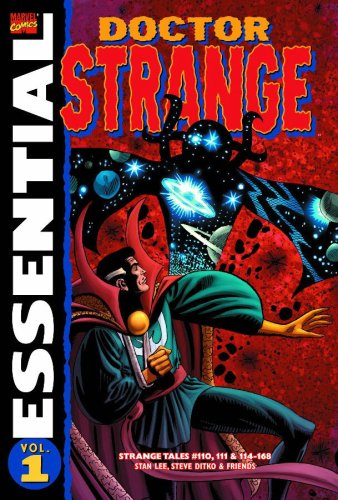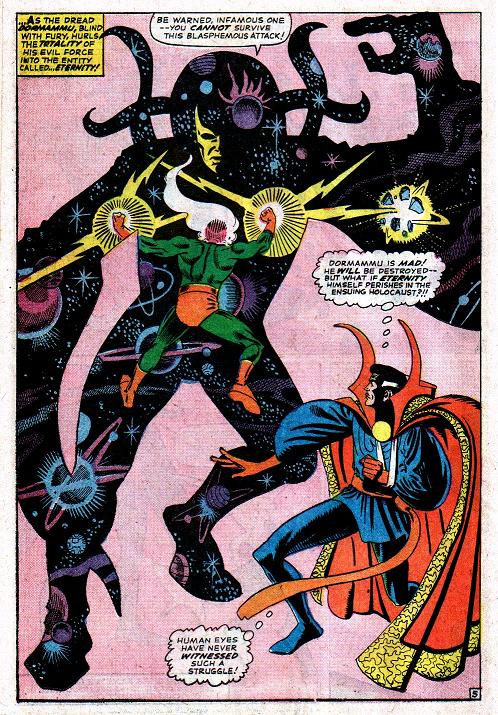
Essential Dr Strange Vol. 1
Stan Lee, Steve Ditko and friends
Reprints Strange Tales #110, #111, #114-168 (August 1963 — May 1968)
Get this for: the complete Ditko-Lee Dr Strange — Five stars
I bought my fiftieth Marvel Essential this week, most of which I’ve bought this year ever since a local remainder shop has been stocking them for less than half of their normal price. It’s been great to be able to buy these huge chunks of Marvel’s Silver Age and Bronze Age history for a price you couldn’t buy two modern comics for. To celebrate I thought I’d do some quick reviews of all of them: Fifty Essentials in Fifty Days. And I’ll start with Doctor Strange.
Essential Doctor Strange vol 1 has the complete run of Doctor Strange in the original Strange Tales, from #111 to #168, including the full run of Steve Ditko. Strange Tales was a split title, with The Human Torch and later Nick Fury, Agent of Shield in the front and Doctor Strange as the backup feature. He started out in a couple of five pages stories, then moved up to eight pagers and by the end of the volume has twelve pages to have his adventures in. A lot happens in these short stories, but there’s much less of the soap opera typical of other Silver Age Marvel titles. In fact, the early Doctor Strange doesn’t feel like a Marvel title at all.
Take the first story. It starts with a man suffering from nightmares recalling hearing about how Doctor Strange could help with situations like this. He goes to visiti him, Strange infiltrates his dreams and it turns out Nightmare is behind the guy’s troubles, attempting to lure Strange. into his own realm. While Strange is held off by Nightmare, his pawn wakes up and realises why he was having terrible dreams: he’s been ripping people off in crooked business deals. He decides to kill Doctor Strange, but luckily the latter manages to use his magical amulet to stop him. It ends with Nightmare making threats to get Strange another time, while the good doctor convinces his patsy to turn himself in: “it will be the only way you can ever sleep again”.
Now this is the sort of strange mystery story you could also picture The Phantom Stranger starring in, somewhat of a throwback of what Marvel was doing just before they got into superheroes. It’s also clear that this is far from Doctor Strange’s first case: he’s well known enough that there are rumours about him and people know where to find him to get his help. No origin is given either, which makes him about the only classic Silver Age Marvel hero not to get their origin in their first story. It’s only in the fourth story that we do get the origin story, of how he once was a great surgeon until a car accident, drunk himself into vagrancy and went looking through the Far East to find a mystical solution for his problems but find himself training as a sorceror under the Ancient One instead… Again, not quite fitting in with the science orientated origins of most of Marvel’s other heroes.
What I liked about this volume was seeing Doc Strange being developed by Steve Ditko and Stan Lee, how seemingly throwaway references to e.g. Dormammu gets picked up later, culminating into the sixteen issue epic battle between Strange and Baron Mordo/Dormammu which ends Ditko’s run. At this point we’re still only halfway through the volume, with the last Ditko free third being so much less interesting, much more pedestrian superheroics. If you read through this volume in one sit, it’s clear that whatever Lee’s contribution to things, it was Ditko who was the creative force behind Doc Strange. The art as well, though in the hands of capable artists like Bill Everett, Marie Severin and Dan Adkins is a huge letdown after Ditko.

What Ditko did with Doctor Strange was create the way in which every subsequent artist would depict magic, creating a whole visual language so to speak to depict other dimensions, magical spells, psychic duels and so on. And he does so while staying firmly within normal panel layouts, not resorting to trickery like breaking panel borders, or unusual layouts or even that many splash pages. It’s all there in the usual three-two-two or three-three-three layout. But when he does do a rare splash page, it’s a beauty, as you can see above…
In short: a great volume of which the last third is not very essential.
Fred W. Hill
September 17, 2010 at 10:43 pmDitko created some truly magical tales with Dr. Strange, and it’s interesting to compare those with his Spider-Man stories. In both, Ditko chronicles the personal growth of the characters — Dr. Strange becomes far less reliant on the Ancient One and even manages to fend for himself when he has been rendered incapable of speaking or gestering with his fingers, severely limiting his power to cast spells; meanwhile, Spider-Man grows from a selfish, self-centered, socially awkward high school kid into a much more confident and self-sacrificing young adult hero.